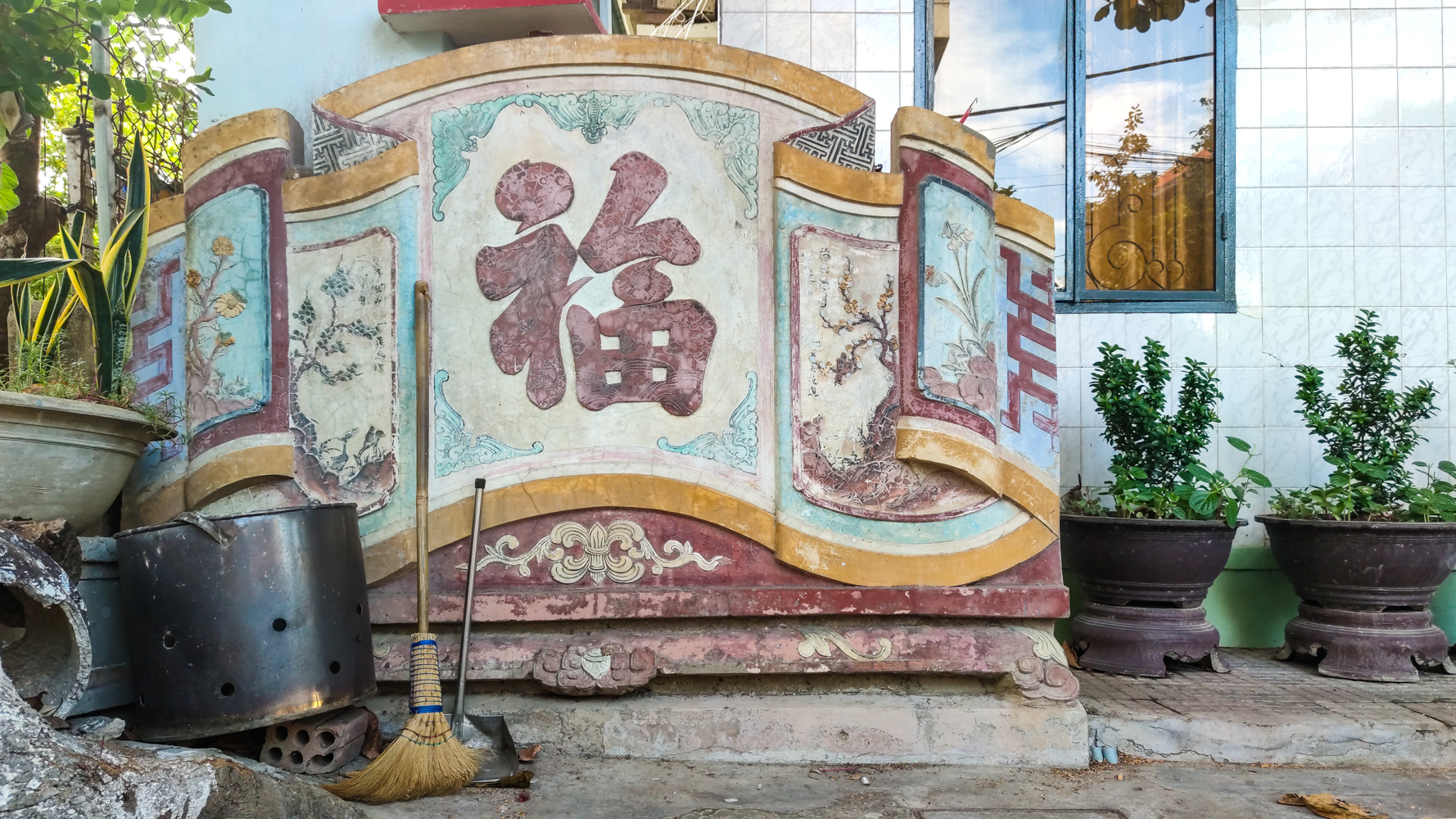Bình phong holds significant, yet declining importance on Vietnamese architecture. They appear, at varying proportions, in the front of buildings, monuments and areas of importance. The word ‘bình phong’ translates into English as screen and they do, to some extent, limit the view of outsider looking inwards, but their primary purpose is to ward off unfavourable forces and elements according to the principles of yin-yang and the Five Elements. This article intends to introduce some basic ideas of the bình phong and provide them with the ability to identify bình phong in Vietnam. The majority of information in this article was taken from other online sources (links below).

Bình phong (screens) were a key feature to various architectural structures in the past such as schools, graves, communal houses, temples, shrines and government buildings. There are a high number of bình phong in Huế since it is the home of the last feudal dynasty. Despite variations in size, shape, design and material, these bình phong share a common purpose. A study conducted in Huế revealed that most homeowners associate the placement of a bình phong at the entrance of their homes with matters of feng shui. The presence of these screens is believed to shield families and buildings from malevolent spirits and detrimental energies. In more modern times, they are also used decoratively, especially for people who want to create a certain cultural identity within the aesthetic of their property.
Natural Bình Phong and man-made Bình Phong
While this article focuses on man made bình phong structures, it should be noted that natural landforms are also used as bình phong too. Following the practice of geomancy (phong thủy / feng shui), important structures such as palaces and tombs would be built in specific positions in accordance with the natural landscape. Two examples of this are the citadel and the Gia Long tomb complex in Huế. The citadel is believed to have been built north of Ngự Bình mountain, so that the mountain would protect the citadel from negative elements. Similarly, the tomb of Gia Long (the first emperor of the Nguyễn dynasty) was built amongst a range of mountains and hills, also acting as a bình phong. Both the Huế citadel and the tombs at the Gia Long complex also include man made bình phong structures.

While the biggest construction projects were given great attention to their relationship to the natural landscape, smaller and less-important buildings tended to rely solely on man-made screens.
What relation does it have to Vietnamese spirituality?
The Vietnamese are influenced by the theories of Feng Shui, so the screen was once an important part of their abode, if it can be afforded. Despite feng shui being a Chinese traditional practice, the bình phong screen is an architectural feature unique to Vietnam than other countries that have followed Chinese geomancy.

According to one article, the screen’s purpose is to prevent the fire element (of the Five Elements) from causing harm or misfortune to the house and the people associated to it. According to the Feng Shui principles, the front of the building belongs to the Fire (south) and can either complement or conflict depending on certain conditions of the construction of the building. If the front of the building is placed in the South direction, the more susceptible it will be to the influence of the fire element, a screen is built to specific dimensions and requirements to reduce any potential risk. As for constructions facing the North, the screen is used less frequently because the north belongs to the element of water (Thuy).
How big should a Bình Phong be?
The appropriate size for a screen is influenced by Feng Shui principles and architectural considerations. According to both Feng Shui and geographical expertise, the screen’s width often matches that of the central building door but is slightly reduced for aesthetic balance. The height is determined based on the building’s eaves. The placement distance of the external screen is usually negotiable but typically equals the width of the structure. However, if situated farther away, an additional layer of front cover or internal support may be recommended. This arrangement is evident in the Hue Imperial Citadel, where the distant Ngu Binh Mountain necessitates secondary structures for shielding. Traditionally the optimal view from the entrance gate includes the front screen and the communal house, reflecting a balance in construction.

Some recurring motifs of the Bình Phong
The Bình Phong screen is structured into three primary components:
Base: Some screens feature a simple rectangular base, while others exhibit intricate patterns such as clouds and ocean waves.
Body: Comprising two symmetrical wings, often adorned with parallel inscriptions, depictions of the four cardinal directions, fruit bowls, and treasure vessels. The central area usually features the word “Tho,” “Phuoc,” or the imagery of the Four Spirits (Dragon, Unicorn, Turtle, Phoenix).
Top: The presence of this section is common in palace screens but rarely in smaller structures.

Screens often include intricate decorative artistry that can be categorised into three groups: script, animal motifs, and decorative elements. The word thọ features most frequently, followed by Phước as the screens purpose is to the benefit of the residents’ luck and longevity. Animal motifs often encompass the Four Spirits—dragon, unicorn, phoenix, and turtle. Tigers also often make an appearance, moreso in the south and in communal houses. Floral, leaf, and rattan scroll motifs are commonly employed in screen designs.
While stone brick remains the prevalent material to make the screens, screens can also be crafted from bamboo and hedges.
The Future of Bình Phong
Not only does the bình phong continue to serve an important role within Vietnamese architecture but it is also a cherished presence across the inhabited landscapes of Vietnam. Although there is evidence of a small percentage of people continuing to include the bình phong in the architecture of their property, the preference for more international forms of architecture and a decline in practices of geomancy means a decline in the bình phong. Furthermore, some screens face deterioration due to the lack of safeguarding and preservation. While government conservation groups protect buildings of significant cultural importance, smaller buildings and buildings that are privately owned are at the peril of their owners and the future of the land. It is to be determined what will become of the bình phong in the future.



















All photos for this article were taken around Huế in July 2021 using a smartphone (Xiaomi t10).
Sources:
http://huetourism.gov.vn/BINH-PHONG-TRONG-KIEN-TRUC-TRUYEN-THONG.html/?pid=MTk4NDR8Y3NkbGRs0
http://tapchisonghuong.com.vn/tap-chi/c142/n1475/Binh-phong-trong-kien-truc-truyen-thong-Viet.html
https://gotrangtri.vn/kien-truc-binh-phong-trong-nha-vuon-truyen-thong-cua-nguoi-hue/
https://cand.com.vn/Phong-su-Tieu-diem/Buc-binh-phong-trong-doi-song-tinh-than-nguoi-Viet-i551729/




